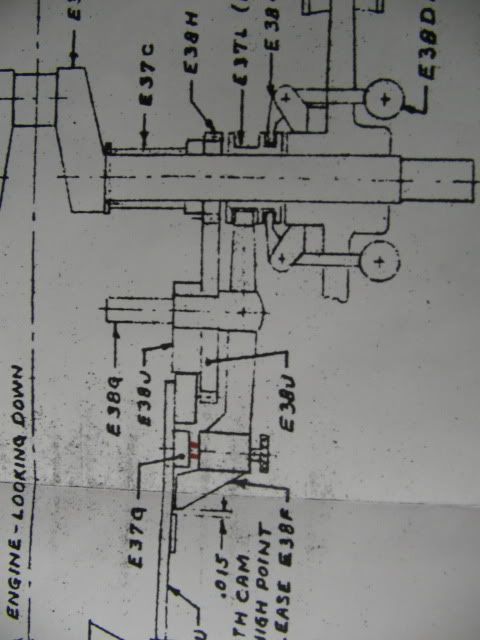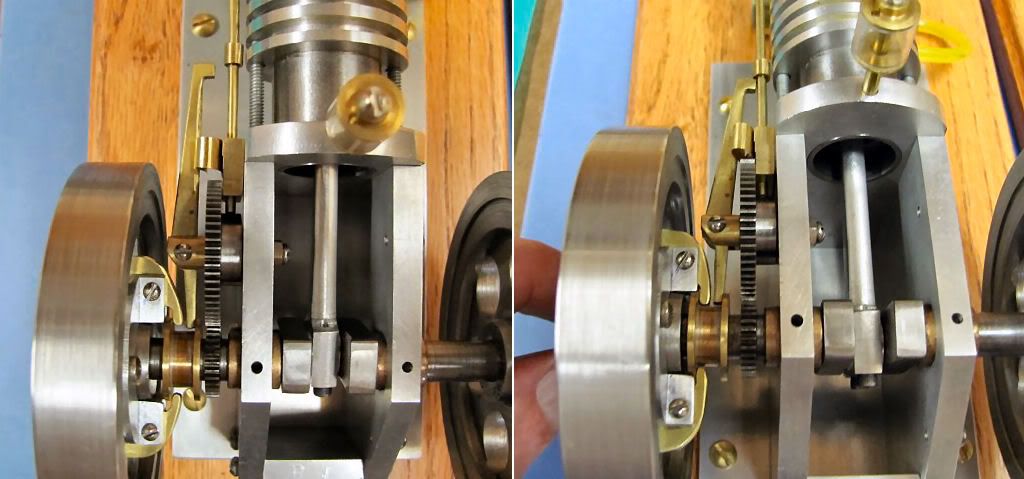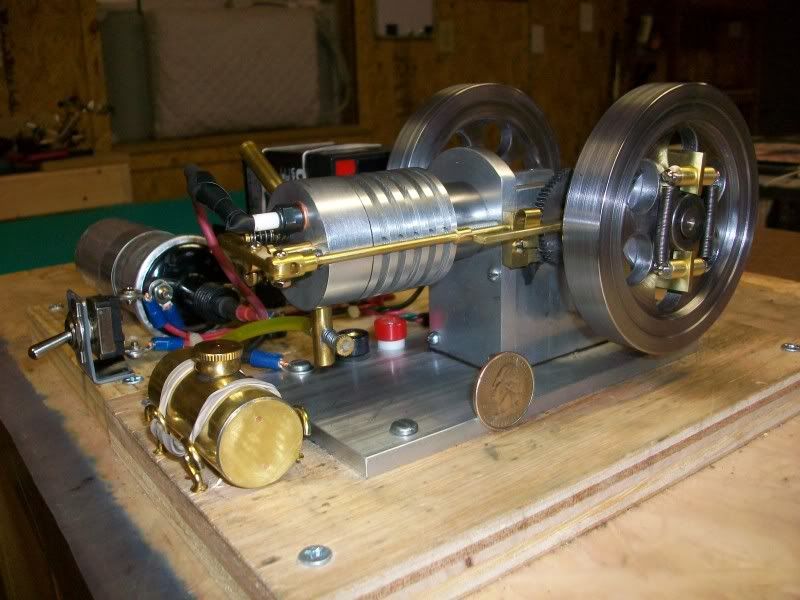This is a question directed at those among us who have built running model hit and miss engines. The lever which swings over and "props up" the exhaust valve to keeep it from closing. It appears on the engine I have built that this is a very finicky adjustment, to get it to work. My observations so far, are that #1---the engine has to be running at what seems to be a very fast clip, in order for it to miss for a few revolutions, then actually pick up and start running again and not just die out. Far faster than full sized hit and miss engines.---Perhaps that desireable slow speed in not "scaleable". #2--there seems to be a very close relationship between the strength of the bobweight retraction springs and the speed at which the engine begins to "miss". This is what I expected, and obviously the stronger the springs are, the higher the engine will rev before the weights move.----However, on my engine at any rate, the speed seems to be somewhat fixed. I have found a very narrow band of adjustment on the needle valve where the engine runs well, and it is not a "fast" speed---more akin to the second video posted in my 'Kerzel build". As a consequence, I hesitate to put stronger springs on my bob-weights in case the engine never actually reaches a high enough RPM for the weights to move at all. I don't know what to do to get my engine to rev any faster, short of advancing the ignition timing. I theorize that instead of stronger springs, I could probably fabricate new, heavier bob weights to achieve the same ends. The springs themselves are a problem because there is not a wide selection (in fact NO selection) of springs available here with a loop on both ends such as I require. I would welcome any insights that might be provided by knowledgeable members.----Brian
You are using an out of date browser. It may not display this or other websites correctly.
You should upgrade or use an alternative browser.
You should upgrade or use an alternative browser.
Hit and miss levers
- Thread starter Brian Rupnow
- Start date

Help Support Home Model Engine Machinist Forum:
This site may earn a commission from merchant affiliate
links, including eBay, Amazon, and others.
- Joined
- Dec 28, 2008
- Messages
- 1,731
- Reaction score
- 9
Brian. Try changing the spring/spring preasure on the lever/arm. I heard that this spring pressure is critical.
I re-read your post and don't understand. Are you trying to get it to run faster, or have it miss to run slow?
-MB
I re-read your post and don't understand. Are you trying to get it to run faster, or have it miss to run slow?
-MB
MB--On my engine there is no spring pressure on the lever arm, other than that supplied by the retract springs on the bobweights. Are the engines you are building different?
- Joined
- Dec 28, 2008
- Messages
- 1,731
- Reaction score
- 9
Brian Rupnow said:MB--On my engine there is no spring pressure on the lever arm, other than that supplied by the retract springs on the bobweights. Are the engines you are building different?
On the Upshur a spring applies pressure on the 'lever', and the weights also have springs. The models I have seen all had this spring and many are adjustable.
-MB
cl350rr
Well-Known Member
- Joined
- Jun 23, 2009
- Messages
- 201
- Reaction score
- 7
Brian, you could do some testing using small rubber bands to bring the spring tension up incrementally (sp?).
if the engine will not run any faster than you may be restricted by the amount of air that it is capable of pulling in.
Randy
if the engine will not run any faster than you may be restricted by the amount of air that it is capable of pulling in.
Randy
Hello Brian, Here are acouple of things to try.
Firstly try running with only one of the springs on the bob weights, this should prove if your spring tension is too much. Another point I have found is that if I adjust the flywheel position, with the bob weights fully retracted in the inward position, so that the detent arm for the pushrod just clears the latch plate when it is not engaged.
On another note, the weight of the flywheels makes a big difference to the speed the engine will run at, and number of miss cycles.
This is just a few things I have found on the model IC engines I have made, hope you understand the above and it is of some help.
MartinH
Firstly try running with only one of the springs on the bob weights, this should prove if your spring tension is too much. Another point I have found is that if I adjust the flywheel position, with the bob weights fully retracted in the inward position, so that the detent arm for the pushrod just clears the latch plate when it is not engaged.
On another note, the weight of the flywheels makes a big difference to the speed the engine will run at, and number of miss cycles.
This is just a few things I have found on the model IC engines I have made, hope you understand the above and it is of some help.
MartinH

$519.19
$699.00
FoxAlien Masuter Pro CNC Router Machine, Upgraded 3-Axis Engraving All-Metal Milling Machine for Wood Acrylic MDF Nylon Carving Cutting
FoxAlien Official
![DreamPlan Home Design and Landscaping Software Free for Windows [PC Download]](https://m.media-amazon.com/images/I/51kvZH2dVLL._SL500_.jpg)
$0.00
DreamPlan Home Design and Landscaping Software Free for Windows [PC Download]
Amazon.com Services LLC

$39.99
$49.99
Sunnytech Low Temperature Stirling Engine Motor Steam Heat Education Model Toy Kit For mechanical skills (LT001)
stirlingtechonline

$94.99
$109.99
AHS Woodmaster 4400 Maintenance Kit for Outdoor Wood Boiler Treatment
Alternative Heating & Supplies

$99.99
AHS Outdoor Wood Boiler Yearly Maintenance Kit with Water Treatment - ProTech 300 & Test Kit
Alternative Heating & Supplies

$24.99
$34.99
Bowl Sander Tool Kit w/Dual Bearing Head & Hardwood Handle | 42PC Wood Sander Set | 2" Hook & Loop Sanding Disc Sandpaper Assortment | 1/4" Mandrel Bowl Sander for Woodturning | Wood Lathe Tools
Peachtree Woodworking Supply Inc

$39.58
$49.99
Becker CAD 12 3D - professional CAD software for 2D + 3D design and modelling - for 3 PCs - 100% compatible with AutoCAD
momox Shop

$89.99
Outdoor Wood Boiler Water Treatment Rust Inhibitor- AmTech 300 & Test Kit
Alternative Heating & Supplies

$45.99
Sunnytech Mini Hot Air Stirling Engine Motor Model Educational Toy Kits Electricity HA001
stirlingtechonline
Thanks fellows---Does anyone have a clear picture of this area on an Upshur they could post, showing this spring which I apparently lack?
fcheslop
Well-Known Member
Hi Brian,as already mentioned the springs on the bob weights and the amount of movement for the arm to lock needs to be set by trial and error to find the right setting .I had to also make larger weights than specified for Little angle to hit n miss and she still runs a little fast for my liking
Brian, the small spring on the detent lever as mentioned as fit to the Upshur may not help you. It goes between the detent lever and somewhere on the frame to aid pushing the detent lever off to allow the engine to `hit`. This may make your problem worse as it is another spring that you will need to overcome with the inertia of the bob wieghts. I have made them with and without this spring fit. The bob wieghts pushing against the collar on the crank should be enough to clear the detent lever from the latch. I , after watching the vids again, would be inclined to get the detent lever to just brush over the latch plate in the off position. This then gives very little travel of the collar to move the lever to the `miss` position. then it should be down to spring pressure on the bob wieghts to give you the speed control.
Hope you can follow this Brian, I tend to get myself lost sometimes.
Cheers,
MartinH
Hope you can follow this Brian, I tend to get myself lost sometimes.
Cheers,
MartinH
Martin--I understand exactly what you mean, but would still like to see a picture. I am supposed to be a design engineer. Bearing that in mind, I can probably design an adjustable spring set up that can be adjusted while the engine is running.-However---a picture of an existing spring set-up would be a big help.---Brianmh121 said:Brian, the small spring on the detent lever as mentioned as fit to the Upshur may not help you. It goes between the detent lever and somewhere on the frame to aid pushing the detent lever off to allow the engine to `hit`. This may make your problem worse as it is another spring that you will need to overcome with the inertia of the bob wieghts. I have made them with and without this spring fit. The bob wieghts pushing against the collar on the crank should be enough to clear the detent lever from the latch. I , after watching the vids again, would be inclined to get the detent lever to just brush over the latch plate in the off position. This then gives very little travel of the collar to move the lever to the `miss` position. then it should be down to spring pressure on the bob wieghts to give you the speed control.
Hope you can follow this Brian, I tend to get myself lost sometimes.
Cheers,
MartinH
- Joined
- Jul 16, 2007
- Messages
- 3,059
- Reaction score
- 1,191
Hi Brian,
Before you even get into making the adjustments on the kick-out levers and governor weights the engine has to be able to start reliably at just a flip over. I'm not saying that yours won't I'm just saying that if the engine is picky about starting then hooking up the 'miss' apparatus will just make the problem worse.
What you can do is put a spring on the governor weights. Just start out with a reasonably sized spring. Install all the levers and such and then pull the spark plug and spin the engine over with an electric drill. Watch to see at what rpm the latch lever engages, if it looks like the rpm is close to where you want to be the the spring is fine. If you want it to 'hook up' at a different rpm then you will have to experiment with other spring weights. Don't worry about trying to find a spring with a loop on the end just take an expansion spring and bend out the first loop.
Once you have the mechanism working at about the rpm you want, start the engine and make the carb adjustments for that rpm.
The additional spring on the kick-out arm is so that the engine rpm can be adjusted on the fly. It's like many other governed engines, if you want to speed it up a little you can override the governor to increase the speed but I wouldn't worry about that until you get the basic problems solved.
George
Before you even get into making the adjustments on the kick-out levers and governor weights the engine has to be able to start reliably at just a flip over. I'm not saying that yours won't I'm just saying that if the engine is picky about starting then hooking up the 'miss' apparatus will just make the problem worse.
What you can do is put a spring on the governor weights. Just start out with a reasonably sized spring. Install all the levers and such and then pull the spark plug and spin the engine over with an electric drill. Watch to see at what rpm the latch lever engages, if it looks like the rpm is close to where you want to be the the spring is fine. If you want it to 'hook up' at a different rpm then you will have to experiment with other spring weights. Don't worry about trying to find a spring with a loop on the end just take an expansion spring and bend out the first loop.
Once you have the mechanism working at about the rpm you want, start the engine and make the carb adjustments for that rpm.
The additional spring on the kick-out arm is so that the engine rpm can be adjusted on the fly. It's like many other governed engines, if you want to speed it up a little you can override the governor to increase the speed but I wouldn't worry about that until you get the basic problems solved.
George
I have just nipped out to the workshop and found a drawing from the little Amanco that shows the layout for you Brian. Sorry I don`t have a scanner but you should be able to see from the pic the info you need. The marks in red are where the spring goes and the thumbscrew is for the adjustment.
Cheers,
MartinH

Cheers,
MartinH

rudydubya
Well-Known Member
- Joined
- Nov 26, 2008
- Messages
- 337
- Reaction score
- 7
Brian, here's a picture of the rod-latch return spring on the Upshur, just a small piece of bent brass sheet located just forward of the cam gear. The reason for the spring on the Upshur is, as you can see, the governor bobbin has no center web, so that the wheel weight arms don't have anything to push back against. So the need of the spring to push the latch back.

This view shows it from the side.

Hope this helps.
Rudy

This view shows it from the side.

Hope this helps.
Rudy
Thank you Rudy---Great pictures. If you have a video of that beauty running in hit n miss mode, why not post it up here. I am constantly trying to upgrade my knowledge of these engines, and every bit helps.---Brian
rudydubya
Well-Known Member
- Joined
- Nov 26, 2008
- Messages
- 337
- Reaction score
- 7
Brian, thanks. Videos of it running in hit-and-miss mode from last year. Second video there shows it running unthrottled, throttled, and hit-and-miss.
http://www.homemodelenginemachinist.com/index.php?topic=4709.msg47494#msg47494
Rudy
http://www.homemodelenginemachinist.com/index.php?topic=4709.msg47494#msg47494
Rudy
My God Rudy---Thats lovely!!!! Do you have a set of plans for the carb you are using when running in hit and miss mode?
Hey Rudy, that's one fine looking engine.
You outta test your engine to see if its going to run at the desired rpm. Do that by operating the exhaust valve manually. When it revs higher than you'd like manually hold the exhaust valve open for a bit. When it slows down to the point it need a kick let the valve close. It should catch and start again. Two things to check: If the tank is too low the gas will siphon back some during the coast period causing it to hesitate, sometimes to the point of quiting. Number two: If the piston fit is not good enough it won't run slowly.
You outta test your engine to see if its going to run at the desired rpm. Do that by operating the exhaust valve manually. When it revs higher than you'd like manually hold the exhaust valve open for a bit. When it slows down to the point it need a kick let the valve close. It should catch and start again. Two things to check: If the tank is too low the gas will siphon back some during the coast period causing it to hesitate, sometimes to the point of quiting. Number two: If the piston fit is not good enough it won't run slowly.
Similar threads
- Replies
- 1
- Views
- 555
- Replies
- 0
- Views
- 304
- Replies
- 83
- Views
- 10K
- Replies
- 0
- Views
- 539
- Replies
- 48
- Views
- 2K







































